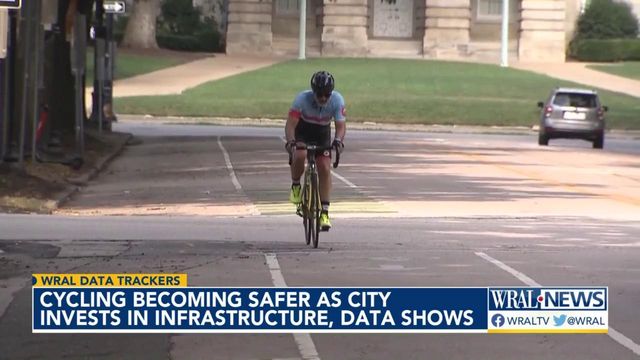Raleigh's investment in cycling infrastructure paying off in big way, data shows
If you feel like you’ve noticed more people cycling around Raleigh over the last few years, you’re right.
About 1,500 people in the city rely on two wheels to get around to work, according to census data. That’s more than twice what it was five years ago.
Kevin Durso is one of them. He began cycling when he was a student at North Carolina State University.
"I needed to get to work and class and I didn't have a car," Durso said. "I rode all over downtown Raleigh and campus as my primary way of transportation."
At first, he borrowed a bike from his roommate. Then, he brought his bike back from home. A year later, he decided to buy a road bike. A decade later, cycling is still a big part of Durso's life.
"It’s easy to get around downtown on a bike," he said. "It’s fun. It’s a big part of my life in terms of fitness and athleticism."
Durso rides regularly to commute to places. He works as a bike mechanic at Oak City Cycling and is part of the racing circuit.
Durso relocated for a few years and when he returned, he noticed the improvements to the infrastructure and the city beginning to embrace bikes more.
"There’s definitely improvements to the greenways and places to ride your bikes around the city over the last few years," he said. "It’s cool to see where we’re going."
The city has been investing in infrastructure like protected and unprotected bike lanes and greenway systems. A look at the data shows that investment is paying off in a big way, by keeping cyclists safer.
Not only are there fewer crashes but, when there is a crash, it’s less likely to result in an injury, according to the data. In 2018, there were 19 cyclists injured for every 100,000 Raleigh residents. Last year, it dropped below five crashes per 100,000 residents — even as the city’s population and interest in cycling grew.
Durso says there are still challenges, but small changes to the streets are important.
"There’s a whole list of things that can happen in a community to help make it a better place for cycling," he said. "More connectivity between the places we like to ride is probably an easy thing to do. But it’s difficult to expand things for bikes in a world that’s dominated by cars."
Interactive Map: Click or tap here to view a map of Raleigh's biking trails
WRAL Data Trackers, delivered to your inbox
Subscribe to the WRAL Data Trackers: Raleigh email newsletter for specific, data-driven updates in what's going on in your Raleigh neighborhood.
Choose one or more of Raleigh's 18 neighborhoods and get a weekly, hyper-local update on the data that drives your quality of life, from crime stats to real estate sales to construction or traffic. Compare trends over time or see how your neighborhood compares to the city at large.
Choose your neighborhood and subscribe: https://www.wral.com/datatrackers/












